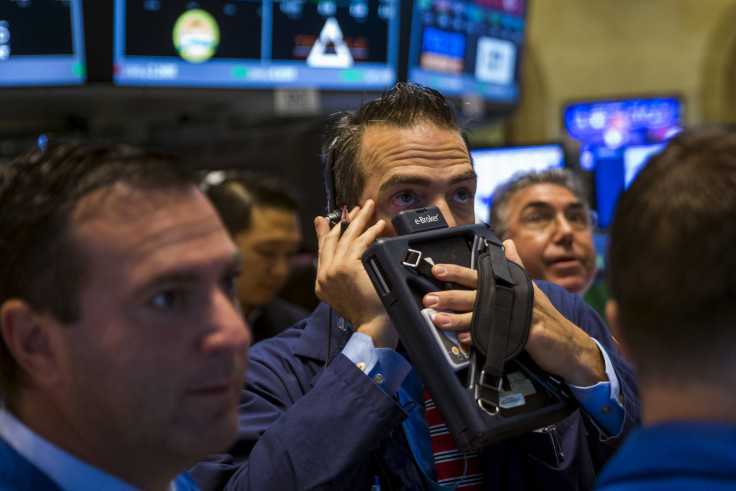Dow Jones Industrial Average Nosedives After Global Stocks Plunge On China Growth Fears

This story was updated at 4:15 p.m. EDT
U.S. stocks tumbled Tuesday, with the Dow Jones Industrial Average dropping nearly 500 points on renewed global slowdown concerns. The losses come as new data revealed factory production in China shrank in August at its fastest pace in more than six years, sending shares in Asia, Europe and the U.S. on a slide for the first trading day of September.
All three major U.S. indexes lost more than 2 percent, pushing the blue-chip Dow and the Standard & Poor's 500 into correction territory. The Nasdaq composite erased all of its gains for the year, joining the Dow and S&P 500 in turning negative for the year.
“The Asian giant’s slowdown could weigh severely on emerging markets' growth, and in turn slow Europe and the U.S.,” Gregory Daco, head of U.S. macroeconomics at Oxford Economics, said in a research note.
The Dow Jones Industrial Average (INDEXDJX:.DJI) closed down 470 points, or 2.8 percent, to 16,058. The Standard & Poor's 500 index (INDEXSP:.INX) lost 58 points, or 3 percent, to 1,914. And the Nasdaq composite (INDEXNASDAQ:.IXIC) fell 140 points, or 2.9 percent, to 4,636.
The New York Stock Exchange invoked Rule 48 Tuesday for the fourth time in two weeks to preempt panic selling.
All 10 of the Standard & Poor's 500 sectors traded lower, led by a 3 percent decline in energy stocks after U.S. oil prices dropped below $46 a barrel. The financial and materials sectors also weighed on the index, shedding more than 2 percent.
Energy also led the Dow sharply lower, with Exxon Mobil Corporation (NYSE:XOM) losing roughly 4 percent.
Separate data released Tuesday showed the pace of U.S. manufacturing growth slowed in August to its weakest rate in over two years. The Institute for Supply Management (ISM) said its index of national factory activity fell to 51.1 last month from 52.7 in July, its lowest reading since May 2013.
U.S. crude oil prices snapped a three-day rally Tuesday, falling below $46 a barrel, a day after posting its biggest three-day percentage increase since 1990.
West Texas Intermediate crude, the benchmark for U.S. oil prices, lost 7.7 percent to $45.41 per barrel for October delivery on the New York Mercantile Exchange. On the London ICE Futures Exchange, Brent crude, the global benchmark for oil prices, sank 8 percent to $49.52.
Treasury yields edged lower, with the 10-year Treasury yield falling to 2.17 percent.
The sharp declines Tuesday follow last week’s global selloff as more signs pointed to China’s economy decelerating at a much-faster-than-expected pace, raising questions about the government’s ability to prop up the economy.
First, China unexpectedly devalued the yuan three weeks ago, and then preliminary data on Aug. 21 showed production in Chinese factories shrank significantly in August.
Adding to concerns Tuesday, the final Caixin/Markit manufacturing purchasing managers' index (PMI) fell to 47.3 in August, down from 47.8 in July. It was the worst reading since March 2009, sending China’s benchmark Shanghai Composite down more than 1 percent. The index has lost roughly 40 percent of its value from its peak in mid-June.
The losses also spilled over to Japan's Nikkei 225 index, which dropped nearly 4 percent. Meanwhile, European stocks closed lower Tuesday, with the pan-European STOXX 600 lost 2.9 percent in afternoon trading, while London's FTSE 100 sank 3 percent. Meanwhile, Germany's DAX and France's CAC lost 2.3 percent and 2.4 percent, respectively.
However, the data was mildly higher than the initial “flash” reading of 47.1 reported on Aug. 21. A reading above 50 indicates an expansion in activity while a reading below signals a contraction.
Separately, China's government released PMI data Tuesday, which slipped to 49.7 in August, marking its weakest level since August 2012. This was down from 50 in July and in line with analysts’ projections. However, this is the first time the official PMI has fallen below 50 in six months, according to Nomura.
Caixin's China PMI data tends to focus on smaller and medium-sized companies, filling a hole that isn't covered by the government's official data.
Wall Street is looking ahead to a speech from Boston Federal Reserve President Eric Rosengren, a nonvoting member of the Federal Open Market Committee, who is scheduled to speak about the U.S. economy Tuesday at 1:15 p.m. EDT at the Forecasters Club of New York.
Market professionals will be watching for further hints about the timing of the U.S. central bank's next interest rate hike. Most economists had forecast the central bank would announce raising rates at its upcoming Sept. 16-17 meeting, which would mark the first rate increase in nearly a decade.
However, the meeting comes at a pivotal time as global markets reacted violently in August to signs China's economy is decelerating at a much faster pace than expected. Rates have hovered near historic lows since the global financial crisis, and experts fear an economic slowdown in the world’s second-largest economy could stall the U.S. recovery following the Great Recession.
© Copyright IBTimes 2024. All rights reserved.






















